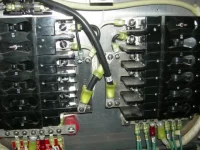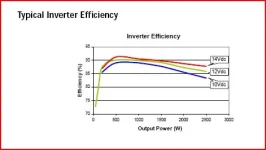scottwvyc
Active member
- Joined
- May 15, 2005
- Messages
- 98
- Hatteras Model
- 37' CONVERTIBLE (1977 - 1982)
I would like to install my Heart Freedon 20 charger/inverter (2000w). I think I have most of it figured out with the exception of wiring the panel. My panel, as you can see in the picture below, is split into two sides. I only want inverter power going to boat's recepticles to run the tv, microwave, and coffee maker, ect. The top breakers on each side are the breakers for the recepticles and are ground fault protected, the other breakers are ganged together and power the water heater, stove, and AC side of the fridge ect. My question is, how do I "split the panel" to power those top two breakers and not the rest, yet still power the recepticle breakers when I am hooked to shore power or running the generator?
Thank-you
Scott
Thank-you
Scott



